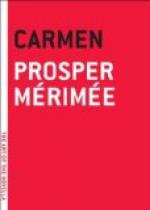|
This section contains 7,216 words (approx. 25 pages at 300 words per page) |

|
SOURCE: Mickelson, David J. “Travel, Transgression, Possession in Mérimée's Carmen.” Romanic Review 87, no. 3 (May 1996): 329-44.
In the following essay, Mickelson reads Carmen “as a flirtation with danger encountered during travel.”
“Je vais aller en Espagne, c'est-à-dire en Afrique.”
—Stendhal
“Comment ferez-vous pour parler de l'Espagne quand vous y serez allé?”
—Heine to Gautier
There's more to Carmen than meets Bizet. Explications of Mérimée's best-known novella often concentrate, like the opera, on the title character, but these readings hardly do justice to the novella's complex cultural displacements and intersections.1 A pseudo-love story, Carmen is better viewed as an unequal confluence of cultures in which the pivotal figure is not the Gypsy Carmen but the French narrator visiting Spain. More closely examining his role (and that of his framed narrator, José) helps reveal the cultural imperatives operating within this text, in particular its covert colonialist...
|
This section contains 7,216 words (approx. 25 pages at 300 words per page) |

|


